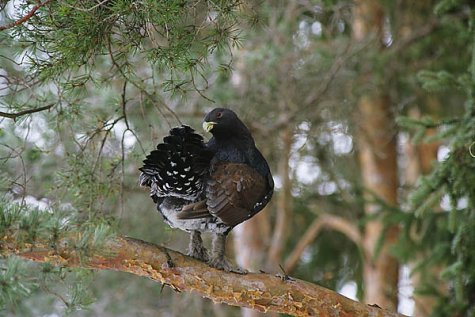Capercaillies are birds of large forests
Photo: Arne Ader
Translation: Liis
Capercaillie cock.
| Western capercaillie, wood grouse |
Metsis
|
In the forest capercaillies, or wood grouse, prefer to live on sandy, conifer-forested bog islets: there is less disturbance, and a better overview of the surroundings, so less dangers. For winter sightings of capercaillies typical places are bogs, bog pine forests and areas bordering to them. The capercaillie is our largest bird in the galliforms or landfowls order; a sturdy, fully-grown cock weighs somewhere around 4 kilos, the hens are less than half that weight. They mostly move and live on the ground. But the snow cover is thick now and the basic food is pine needles with low nutritional value. A magnificent view – a goose-sized bird of the woods in a tree. In one feeding session at least about two hundred grams of pine needles have to be eaten and to "mill” the hard and sharp needles the birds need small pebbles in their crop, as is characteristic for galliform birds. This is why they can be encountered pecking on quiet gravelled roads. The feet of the capercaillies have a covering of hair-like feathers that grows denser in winter; at the sides of the toes small elongated horny strips or tacks grow out, helping to hold on to icy pine branches and also making it easier to run on thick snow.
The slightly odd name capercaillie comes from the Gaelic capull coille, meaning "horse of the woods".
The slightly odd name capercaillie comes from the Gaelic capull coille, meaning "horse of the woods".









